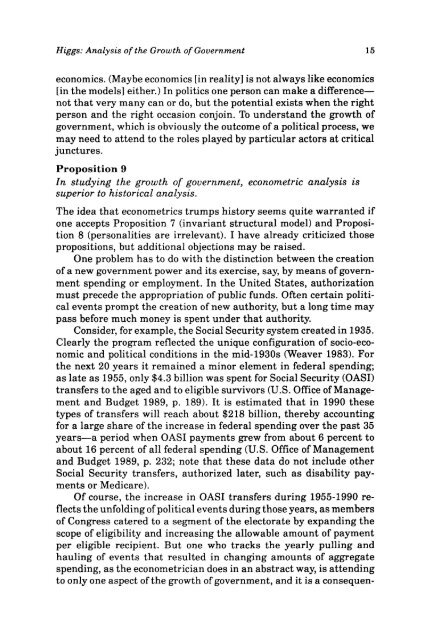Review of Austrian Economics - The Ludwig von Mises Institute
Review of Austrian Economics - The Ludwig von Mises Institute
Review of Austrian Economics - The Ludwig von Mises Institute
You also want an ePaper? Increase the reach of your titles
YUMPU automatically turns print PDFs into web optimized ePapers that Google loves.
Higgs: Analysis <strong>of</strong> the Growth <strong>of</strong> Government 15<br />
economics. (Maybe economics [in reality] is not always like economics<br />
[in the models] either.) In politics one person can make a difference—<br />
not that very many can or do, but the potential exists when the right<br />
person and the right occasion conjoin. To understand the growth <strong>of</strong><br />
government, which is obviously the outcome <strong>of</strong> a political process, we<br />
may need to attend to the roles played by particular actors at critical<br />
junctures.<br />
Proposition 9<br />
In studying the growth <strong>of</strong> government, econometric analysis is<br />
superior to historical analysis.<br />
<strong>The</strong> idea that econometrics trumps history seems quite warranted if<br />
one accepts Proposition 7 (invariant structural model) and Proposition<br />
8 (personalities are irrelevant). I have already criticized those<br />
propositions, but additional objections may be raised.<br />
One problem has to do with the distinction between the creation<br />
<strong>of</strong> a new government power and its exercise, say, by means <strong>of</strong> government<br />
spending or employment. In the United States, authorization<br />
must precede the appropriation <strong>of</strong> public funds. Often certain political<br />
events prompt the creation <strong>of</strong> new authority, but a long time may<br />
pass before much money is spent under that authority.<br />
Consider, for example, the Social Security system created in 1935.<br />
Clearly the program reflected the unique configuration <strong>of</strong> socio-economic<br />
and political conditions in the mid-1980s (Weaver 1983). For<br />
the next 20 years it remained a minor element in federal spending;<br />
as late as 1955, only $4.3 billion was spent for Social Security (OASI)<br />
transfers to the aged and to eligible survivors (U.S. Office <strong>of</strong> Management<br />
and Budget 1989, p. 189). It is estimated that in 1990 these<br />
types <strong>of</strong> transfers will reach about $218 billion, thereby accounting<br />
for a large share <strong>of</strong> the increase in federal spending over the past 35<br />
years—a period when OASI payments grew from about 6 percent to<br />
about 16 percent <strong>of</strong> all federal spending (U.S. Office <strong>of</strong> Management<br />
and Budget 1989, p. 232; note that these data do not include other<br />
Social Security transfers, authorized later, such as disability payments<br />
or Medicare).<br />
Of course, the increase in OASI transfers during 1955-1990 reflects<br />
the unfolding <strong>of</strong> political events during those years, as members<br />
<strong>of</strong> Congress catered to a segment <strong>of</strong> the electorate by expanding the<br />
scope <strong>of</strong> eligibility and increasing the allowable amount <strong>of</strong> payment<br />
per eligible recipient. But one who tracks the yearly pulling and<br />
hauling <strong>of</strong> events that resulted in changing amounts <strong>of</strong> aggregate<br />
spending, as the econometrician does in an abstract way, is attending<br />
to only one aspect <strong>of</strong> the growth <strong>of</strong> government, and it is a consequen-

















